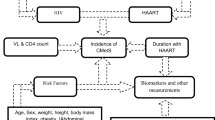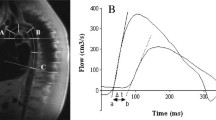Abstract
Metabolic syndrome (MetS) is a cluster of risk factors, including elevated mean arterial pressure (MAP), atherogenic dyslipidemia (elevated triglycerides [TRG]), abdominal obesity (increased body mass index [BMI]), glucose intolerance (elevated glucose [GLU]), and prothrombotic/inflammatory state (increases in uric acid [UA]), that are associated with increased risk of cerebrovascular disease. We studied if an association existed between MetS components and human immunodeficiency virus (HIV)-associated cryptogenic strokes—those not caused by HIV complications, endocarditis, or stimulant abuse. We performed a retrospective case-control study. Eleven cryptogenic strokes were identified from 2346 HIV-infected (HFV+) participants. Each case was matched by age, sex, and date of stroke diagnosis to five HIV+ controls without stroke. Nonparametric stratified Wilcoxon ranked sum tests with subsequent mixed effect logistic regression determined the influence of each MetS component on HIV-associated cryptogenic stroke. Although each MetS component appeared higher for HIV+ cases with cryptogenic strokes than HIV+ controls, only MAP (odds ratio [OR] = 5.70, 95% confidence interval [CI] = 1.15–28.3) and UA (OR = 1.88, 95% CI = 1.06–3.32) were statistically different. A significantly higher percentage of HIV-associated cryptogenic stroke cases met criteria for MetS (4/11 = 36%) compared to HIV+ controls (6/55 = 11%). This observational study suggests a possible role for MetS components in HFV+ cryptogenic stroke cases. Although MetS is defined as a constellation of disorders, elevated hypertension and hyperuricemia may be involved in stroke pathogenesis. Reducing MetS component levels in HIV+ patients could therefore protect them from subsequent stroke.
Similar content being viewed by others
References
Ahmadani MY, Hakeem R, Fawwad A, Basit A, Shera AS (2008). Determination of reference values for elevated fasting and random insulin levels and their associations with metabolic risk factors among rural Pakistanis from Sindh Province. Metab Syndr Relat Disord 6: 143–148.
Ballard CG, Burton EJ, Barber R, Stephens S, Kenny RA, Kalaria RN, O’Brien JT (2004). NINDS AIREN neuroimaging criteria do not distinguish stroke patients with and without dementia. Neurology 63: 983–988.
Bandaru VV, McArthur JC, Sacktor N, Cutler RG, Knapp EL, Mattson MP, Haughey NJ (2007). Associative and predictive biomarkers of dementia in HIV-1-infected patients. Neurology 68: 1481–1487.
Banegas JR, Segura J, Sobrino J, Rodriguez-Artalejo F, de la Sierra A, de la Cruz JJ, Gorostidi M, Sarria A, Ruilope LM (2007). Effectiveness of blood pressure control outside the medical setting. Hypertension 49: 62–68.
Berger JR (2004). AIDS and stroke risk. Lancet Neurol 3: 206–207.
Boden-Albala B (2006). Current understanding of multiple risk factors as the metabolic syndrome: distillation or deconstruction. Semin Neurol 26: 108–116.
Bonita R, Mendis S, Truelsen T, Bogousslavsky J, Toole J, Yatsu F (2004). The global stroke initiative. Lancet Neurol 3: 391–393.
Bonora E (2006). The metabolic syndrome and cardiovascular disease. Ann Med 38: 64–80.
Booth ML, Hunter C, Gore CJ, Bauman A, Owen N (2000). The relationship between body mass index and waist circumference: implications for estimates of the population prevalence of overweight. Int J Obes Relat Metab Disord 24: 1058–1061.
Breslow NE, Clayton DG (1993). Statistic in epidemiology: the case control study. J Am Stat Assoc 88: 9–25.
Buehler JW, Ward JW (1993). A new definition for AIDS surveillance. Ann Intern Med 118: 390–392.
Carr A, Samaras K, Thorisdottir A, Kaufmann GR, Chisholm DJ, Cooper DA (1999). Diagnosis, prediction, and natural course of HIV-1 protease-inhibitor-associated lipodystrophy, hyperlipidaemia, and diabetes mellitus: a cohort study. Lancet 353: 2093–2099.
Cirillo P, Sato W, Reungjui S, Heinig M, Gersch M, Sautin Y, Nakagawa T, Johnson RJ (2006). Uric acid, the metabolic syndrome, and renal disease. J Am Soc Nephrol 17: S165-S168.
Cole JW, Pinto AN, Hebel JR, Buchholz DW, Earley CJ, Johnson CJ, Macko RF, Price TR, Sloan MA, Stern BJ, Wityk RJ, Wozniak MA, Kittner SJ (2004). Acquired immunodeficiency syndrome and the risk of stroke. Stroke 35: 51–56.
Connor MD, Lammie GA, Bell JE, Warlow CP, Simmonds P, Brettle RD (2000). Cerebral infarction in adult AIDS patients: observations from the Edinburgh HIV Autopsy Cohort. Stroke 31: 2117–2126.
Coutinho Tde A, Turner ST, Peyser PA, Bielak LF, Sheedy PF, 2nd, Kullo IJ (2007). Associations of serum uric acid with markers of inflammation, metabolic syndrome, and subclinical coronary atherosclerosis. Am J Hypertens 20: 83–89.
Eckel RH, Grundy SM, Zimmet PZ (2005). The metabolic syndrome. Lancet 365: 1415–1428.
Engstrom JW, Lowenstein DH, Bredesen DE (1989). Cerebral infarctions and transient neurologic deficits associated with acquired immunodeficiency syndrome. Am J Med 86: 528–532.
Falutz J (2007). Therapy insight: body-shape changes and metabolic complications associated with HIV and highly active antiretroviral therapy. Nat Clin Pract Endocrinol Metab 3: 651–661.
Fantoni M, Del Borgo C, Autore C, Barbaro G (2002). Metabolic disorders and cardiovascular risk in HIV-infected patients treated with antiretroviral agents. Ital Heart J 3: 294–299.
Germinario RJ (2003). Anti-retroviral protease inhibitors— ‘a two edged sword?’. IUBMB Life 55: 67–70.
Grundy SM, Cleeman JI, Daniels SR, Donato KA, Eckel RH, Franklin BA, Gordon DJ, Krauss RM, Savage PJ, Smith SC Jr, Spertus JA, Costa F (2005). Diagnosis and management of the metabolic syndrome: an American Heart Association/National Heart, Lung, and Blood Institute Scientific Statement. Circulation 112: 2735–2752.
Hjortnaes J, Algra A, Olijhoek J, Huisman M, Jacobs J, van der Graaf Y, Visseren F (2007). Serum uric Acid levels and risk for vascular diseases in patients with metabolic syndrome. J Rheumatol 34: 1882–1887.
Hoenig JM, Heisey DM (2001). The abuse of power: the pervasive fallacy of power calculations for data analysis. Am Stat 55: 19–24.
Kanellis J, Kang DH (2005). Uric acid as a mediator of endothelial dysfunction, inflammation, and vascular disease. Semin Nephrol 25: 39–42.
Kawamoto R, Tomita H, Oka Y, Ohtsuka N (2006). Relationship between serum uric acid concentration, metabolic syndrome and carotid atherosclerosis. Intern Med 45: 605–614.
Magliano DJ, Shaw JE, Zimmet PZ (2006). How to best define the metabolic syndrome. Ann Med 38: 34–41.
Mangili A, Jacobson DL, Gerrior J, Polak JF, Gorbach SL, Wanke CA (2007). Metabolic syndrome and subclinical atherosclerosis in patients infected with HIV. Clin Infect Dis 44: 1368–1374.
Mochan A, Modi M, Modi G (2003). Stroke in black South African HIV-positive patients: a prospective analysis. Stroke 34: 10–15.
Nolan D (2003). Metabolic complications associated with HIV protease inhibitor therapy. Drugs 63: 2555–2574.
Onat A, Uyarel H, Hergenc G, Karabulut A, Albayrak S, Sari I, Yazici M, Keles I (2006). Serum uric acid is a determinant of metabolic syndrome in a population-based study. Am J Hypertens 19: 1055–1062.
Ortiz G, Koch S, Romano JG, Forteza AM, Rabinstein AA (2007). Mechanisms of ischemic stroke in HIV-infected patients. Neurology 68: 1257–1261.
Pi-Sunyer X (2007). The metabolic syndrome: how to approach differing definitions. Med Clin North Am 91: 1025–1040, vii.
Pickering TG, Hall JE, Appel LJ, Falkner BE, Graves J, Hill MN, Jones DW, Kurtz T, Sheps SG, Roccella EJ (2005). Recommendations for blood pressure measurement in humans and experimental animals: Part 1: blood pressure measurement in humans: a statement for professionals from the Subcommittee of Professional and Public Education of the American Heart Association Council on High Blood Pressure Research. Hypertension 45: 142–161.
Pinto AN (1996). AIDS and cerebrovascular disease. Stroke 27: 538–543.
Qureshi AI, Janssen RS, Karon JM, Weissman JP, Akbar MS, Safdar K, Frankel MR (1997). Human immunodeficiency virus infection and stroke in young patients. Arch Neurol 54: 1150–1153.
Rabinstein AA (2003). Stroke in HIV-infected patients: a clinical perspective. Cerebrovasc Dis 15: 37–44.
Reker DM, Rosen AK, Hoenig H, Berlowitz DR, Laughlin J, Anderson L, Marshall CR, Rittman M (2002). The hazards of stroke case selection using administrative data. Med Care 40: 96–104.
Reynolds T (2007). Serum uric acid, the endothelium and hypertension: an association revisited. J Hum Hypertens 21: 591–593.
Sacktor N, Haughey N, Cutler R, Tamara A, Turchan J, Pardo C, Vargas D, Nath A (2004). Novel markers of oxidative stress in actively progressive HIV dementia. J Neuroimmunol 157: 176–184.
Schretlen DJ, Inscore AB, Vannorsdall TD, Kraut M, Pearlson GD, Gordon B, Jinnah HA (2007). Serum uric acid and brain ischemia in normal elderly adults. Neurology 69: 1418–1423.
Wang X, Chai H, Yao Q, Chen C (2007). Molecular mechanisms of HIV protease inhibitor-induced endothelial dysfunction. J Acquir Immune Defic Syndr 44: 493–499.
Wright CB, Festa JR, Paik MC, Schmiedigen A, Brown TR, Yoshita M, Decarli C, Sacco R, Stern Y (2008). White matter hyperintensities and subclinical infarction. Associations with psychomotor speed and cognitive flexibility. Stroke 39: 800–805.
Author information
Authors and Affiliations
Consortia
Corresponding author
Rights and permissions
About this article
Cite this article
Ances, B.M., Bhatt, A., Vaida, F. et al. Role of metabolic syndrome components in human immunodeficiency virus-associated stroke. Journal of NeuroVirology 15, 249–256 (2009). https://doi.org/10.1080/13550280902962443
Received:
Revised:
Accepted:
Issue Date:
DOI: https://doi.org/10.1080/13550280902962443




